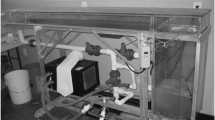Abstract
Water hyacinth growth rates were monitored from May through October in two sewage lagoons with different nutrient loading rates. The lagoon receiving the heaviest load sustained the highest average growth rates throughout the summer. The lightly loaded lagoon averaged a 29% increase in weight per week over the six month period with the highest growth rate occuring during June with an average weekly weight gain of 71%. The heavily loaded lagoon sustained an average growth rate of 46% per week for the same six month period with the highest measured growth rate of 73% increase in weight per week also occuring in June. In addition, the performance of three harvesters was evaluated. One harvester, consisting of a chopper and conveyor, was capable of picking up and chopping approximately 2.3 t of plants per hour and delivering them to a waiting truck. The second harvester was a single 1.52 m (5 ft) wide conveyor, and the third one was a modified clamshell bucket attached to a dragline. The average harvesting rate of each of these harvesters was approximately 9.3 t of water hyacinths per hour.
Similar content being viewed by others
Literature Cited
Alich, J. & R. Inman. 1976. Energy from agriculture. Proceedings of clean fuels from biomass, sewage, urban refuse, and agriculture wastes. 150–172.
Bureau of Aquatic Plant Research and Control. 1972. Evaluation of commercially available water hyacinth harvesters. Department of Natural Resources. U.S. Army Corps of Engineers.
Cornwell, D. A., J. Zoltec, C. D. Patrinely, T. S. Furman & J. I. Kim. 1977. Nutrient removal by water hyacinths. J. Water Poll. Control Fed. 70: 57–65.
Culley, D. C, Jr. & A. E. Epps. 1973. Use of duckweed for waste treatment and animal feed. J. Water Poll. Control Fed. 45: 337–347.
Dinges, R. 1978. Upgrading stabilization pond effluent by water hyacinth culture. J. Water Poll. Control Fed. 50: 833–845.
Dymond, G. C. 1949. The water hyacinth: a Cinderella of the plant world. In: Van Vuren, J. P. J. (ed.). Soil fertility and sewage. Dover Publications. New York.
Greeley, R. S. 1976. Land and fresh water farming. Proceedings of a conference on capturing the sun through bioconversion. 179–208.
McGarry, M. & C. Tongkasome. 1971. Water reclamation and algae harvesting. Water Control J. 43: 824–835.
McNabb, C. D., Jr. 1976. The potential of submersed vascular plants for reclamation of wastewater in temperate zone ponds. In: Tourbier, J. & R. W. Pierson, Jr. (eds.). Biological control of water pollution. University of Pennsylvania Press.
North, W. J. (ed.). 1971. The biology of giant kelp beds (Macrocystis) in California. J. Cramer Publishers. Lehre, Germany.
Oswald, W. 1976. Gas production from micro algae. Proceedings of clean fuels from biomass, sewage, urban refuse, and agriculture wastes. 173–187.
Penfound, W. T. & T. T. Earle. 1948. The biology of the water hyacinth. Ecol. Monogr. 18: 447- 472.
Ryther, J. H. 1976. Ocean farming. Proceedings of a conference on capturing the sun through bioconversion. 289–290.
Scarsbrook, E. & D. E. Davis. 1971. Effect of sewage effluent on growth of five vascular aquatic species. Hyacinth Control J. 9: 26–30.
Schulze, K. L. 1966. Biological recovery of wastewater. J. Water Poll. Control Fed. 38: 1944–1958.
Seidel, K. 1976. Macrophytes and water purification. In: Tourbier, J. & R. W. Pierson, Jr. (eds.). Biological control of water pollution. University of Pennsylvania Press.
Sutton, D. C. & W. H. Ornes. 1977. Growth of Spirodela polyrhiza in static sewage effluent. Aquatic Botany 3: 231–237.
Westlake, D. F. 1963. Comparisons of plant productivity. Biological Review 38: 385–25.
Wolverton, B. C, R. M. Barlow & R. C. McDonald. 1976. Application of vascular aquatic plants for pollution removal, energy, and food production. In: Tourbier, J. & R. W. Pierson, Jr. (eds.). Biological control of water pollution. University of Pennsylvania Press.
- & R. C. McDonald. 1976. Water hyacinths for upgrading sewage lagoons to meet advanced wastewater treatment standards: part II. NASA Technical Memorandum TM-X-72730.
- & -. 1977. Wastewater treatment utilizing water hyacinths (Eichhornia crassipes (Mart.) Solms.) Proceedings of the 1977 national conference on treatment and disposal of industrial wastewaters and residues. 205–208.
- & -. 1979. Nutritional composition of water hyacinths grown on domestic sewage. Economic Botany.
-, -& J. Gordon. 1975. Bioconversion of water hyacinths into methane gas: part I. NASA Technical Memorandum TM-X-72725.
Wooten, J. W. & J. D. Dodd. 1976. Growth of water hyacinths in treated sewage effluent. Economic Botany 30: 29–37.
Author information
Authors and Affiliations
Rights and permissions
About this article
Cite this article
Wolverton, B.C., McDonald, R.C. Water hyacinth (eichhornia crassipes) productivity and harvesting studies. Econ Bot 33, 1–10 (1979). https://doi.org/10.1007/BF02858205
Received:
Accepted:
Issue Date:
DOI: https://doi.org/10.1007/BF02858205




